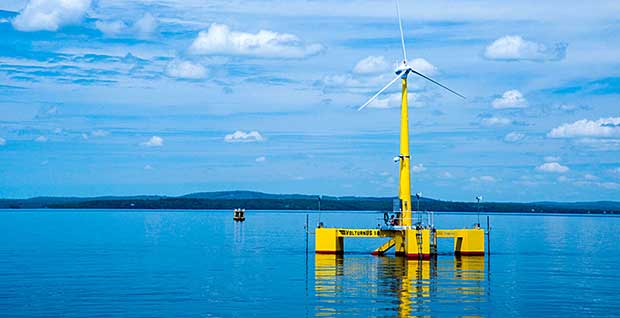The offshore wind sector is facing challenges in establishing itself in the United States due to opposition fueled by a mix of misinformation and a sense of entitlement among its critics. However, Maine seems to have found a solution to this issue. If everything proceeds as intended, Maine, known for its lobsters and lighthouses, may soon be renowned for hosting floating offshore wind turbines.
Offshore Wind Revolution: Maine’s Floating Turbine Initiative
Floating wind turbines offer a solution to the challenge confronting coastal states seeking to tap into clean offshore energy, particularly when faced with obstacles like water depths unsuitable for conventional fixed-platform turbine installation. Additionally, competition from tourism and various maritime industries can pose hindrances.
The answer involves exploring new possibilities for offshore wind locations, which can be achieved by placing turbines on floating platforms anchored to the ocean bed. However, this is a complex task. Floating platforms are costly, and achieving the right equilibrium is a challenging engineering endeavor, especially when we factor in the impact of waves, weather conditions, and the presence of large, rotating wind turbines.
The US Department of Energy has been investing its research and development funds to support the initiation of the global floating wind industry. A notable project in this endeavor has found its way to Maine, through collaboration with the University of Maine.
Maine might appear an unconventional choice for advancing offshore wind technology. It’s a sparsely populated state with existing transmission challenges. Nevertheless, the Gulf of Maine possesses exceptional offshore wind resources, making it an enticing and valuable prospect.
The Connection Between Offshore Wind and Green Hydrogen
Maine is recognized not only for its lobsters and lighthouses, but also for its heavy reliance on home heating oil, which has prompted energy planners to seek alternatives. Floating offshore wind turbines could potentially contribute to solving this energy challenge.
However, relying solely on floating offshore wind turbines to generate additional electricity for Maine’s grid may not fully address the cost and affordability issues tied to electrifying homes and buildings, including the need for new transmission infrastructure.
The situation changes when green hydrogen is introduced into the equation. In March 2020, Maine Governor, Janet Mills, and state officials visited offshore wind farms in Scotland and hinted at the potential of green hydrogen.
In November 2020, CleanTechnica noted the following: “Scotland has begun to leverage its powerful offshore wind industry to produce green hydrogen, and Maine has been eyeballing green hydrogen as a way to deliver more clean kilowatts despite some bottlenecks in its existing transmission system.”
They also stated, “Mitsubishi is involved in the Maine project, having acquired the newly dubbed firm New England Aqua Ventus through a joint venture with its Mitsubishi Renewables Diamond Offshore Wind subsidiary and the firm RWE Renewables.”
What Exactly is Aqua Ventus?
Aqua Ventus came to CleanTechnica’s attention in 2015, when it was still in its experimental phases. It was almost terminated during the tenure of former Republican Governor Paul LePage, but received support from the Energy Department, enabling it to continue as a collaborative research and development effort involving both public and private entities under the University of Maine’s auspices.
The project was initiated in 2011 with the primary objective of developing a new concrete hull, as an alternative to the conventional steel platforms used for constructing floating offshore wind farms.
The University of Maine’s Advanced Structures & Composites Center describes the VolturnUS Hull design as being inspired by and structured like an upside-down bridge. This transformational floating concrete hull technology aims to harness offshore wind energy while potentially reducing the overall cost of offshore wind.
According to the ASCC, the new hull employs standard precast bridge construction techniques that can be applied virtually anywhere globally. Unlike steel, the materials for the concrete hull can be sourced locally, and local labor can be utilized, further enhancing cost-effectiveness.
Additionally, ASCC states that concrete exhibits superior resistance to corrosion compared to steel, resulting in reduced lifetime operation and maintenance expenses. The concrete structure’s heavier weight also provides stability against wave motion.
Furthermore, the design incorporates a low tow-out draft, meaning the hull remains relatively high in the water.
This eliminates the need for specialized deep-water port facilities. ASCC goes ahead to explain that “ “Low tow-out draft allows for deployment in shallow water harbors around the globe.”
Citation
Leave a Reply
You must be logged in to post a comment.
